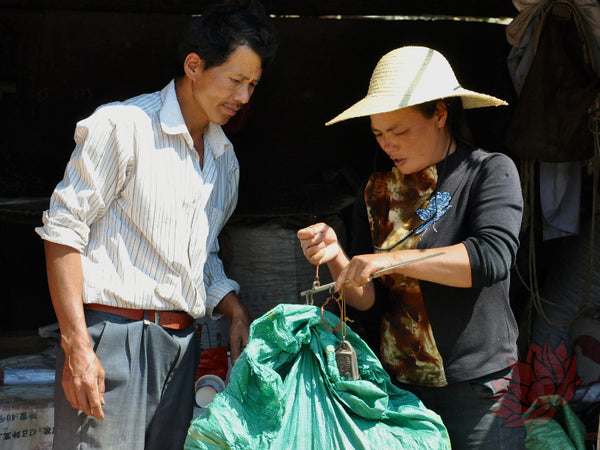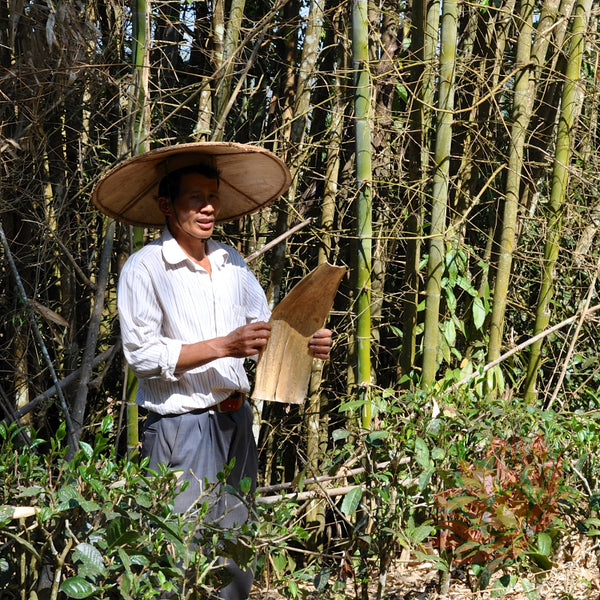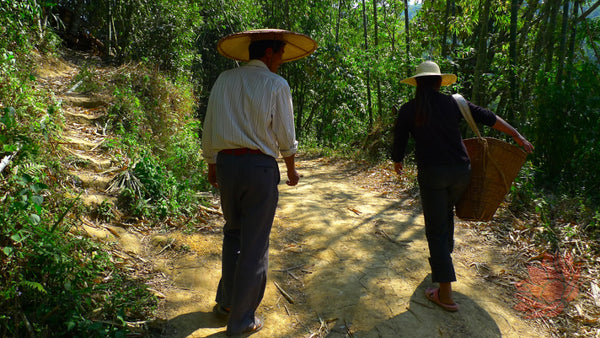Longtan Village March 21 2014

After our pottery adventures in Jianshui we headed south in search of puerh tea. We stopped briefly in Yuanyang to admire the incredible agricultural architecture. More than a thousand years ago farmers began terracing the mountains to create opportunities for level farming where none existed before. The result is both beautiful and impressive. The scale is truly staggering. Primarily used for farming rice, the locals use the Spring return of swallows to gauge the correct time for planting.

To find the puerh we were looking for we would need to travel much further south. The road wound through the mountains with all the predictability of a bowl of noodles. The ribbon of black tarmac we rode was cut with random, nearly impassable sections of dirt and rock. It was as if the road couldn't make up its mind which century it was in. Our valiant, but aging, Mitsubishi Space Wagon stayed true to the course and brought us safely to Jiangcheng.
Three rivers flow through this area giving Jiangcheng the name "River CIty" in Chinese 江城. Part of the succinctly named "Jiangcheng Hani and Yi Autonomous County" this area is right at the borders of both Laos and Vietnam. A Chinese nickname for this area translates to "One Glance Three Countries". South of the Tropic of Cancer, it is humid and warm here year round. The primary ethnicities in this area are the Hani, Yi, and Dai. Tea has long been grown here and is integrated into all aspects of life and culture.
North and east of Jiangcheng are tea gardens with trees whose age is counted by centuries. Our goal was the village of Tianfang. It's not far, but the pavement soon gave way to the dust and rock that would be our constant companions over the course of our trip. We found the road to be blocked and had to travel to a further village and backtrack. We arrived on a Sunday around noon and few people were to be found. Those that were simply pointed to the hills and encouraged us to do what we pleased. We did just that.
We continued up a very steep washed out road, parked the car, and began exploring. We were surrounded by our first puerh tea garden. We started taking pictures but really had hoped to find a local to guide us. I had so many questions to ask. As if by fate a lone motorcycle rider appeared. His dark skin was weathered and worn by a life lived out of doors. His riding gear consisted of a thick sweater, slacks, sandals, and a heavy layer of dust.
As was her custom, Lamu got his attention by yelling "Seifu!". Seifu in Chinese means master and is a common form of respect used when requesting someones attention when you need their help. His face was a mixture of confusion and intrigue. I would get that look a lot. My bald head and waist length braided beard are quite the fascination for the Chinese people we would meet. Not to mention that these areas rarely get foreigners, let alone one as pale as I am. We asked if he could answer our questions about tea trees. He explained that he had his own tea garden nearby and would be picking and roasting tea that afternoon if we wanted to follow him. This was how we met Mr. Li Zhong Shen and found Longtan Village 龙潭.

The sun was peaking and heat was on the rise. We were shown to a small table in the shade of a small tree. Four local teen boys had escaped the heat on a ragged excuse for a couch under the same tree. Mr. Li's wife brought out simple paper cups with loose leaf puerh they had picked 2 days before. We were offered watermelon and sugar cane they had grown themselves. I was surprised when they presented a slow loris they had captured in the local forest to entertain us. I've only seen those used in memes on Reddit, never in real life. I almost felt bad for his captivity, but they sleep 23 hours of the day when they're free anyway.

Longtan Village is a small collection of people and tiny buildings on the floor of a long valley. Longtan in Chinese means "Dragon Lake". The name is far more impressive than the reality. I joked with Lamu that it could have just as easily been named "Dragon Puddle". Despite the diminished stature, it was a source of pride for the locals. The lake was not man made and existed before the farmers did. It provides a critical source of water in the drier seasons. Longtan has grown tea for more than 200 years. The Chinese government has recently invested in Longtan and they are using the money to create a place for farming education and tea tourism.

The relatives on my mothers side are all migrant Swedish farmers who worked the land in Eastern Washington State or wherever else the land called them to. My parents weren't farmers by trade, and neither am I, but I grew up on a farm in Michigan and have farming in my blood. I have a deep respect for these people. I'm drawn to their simple manner and deep knowledge of the earth. Mr. Li reminds me so much of my Swedish uncles. The only difference is he is half their size.
Mr. Li owns around 150mu of tea garden. A mu is a measurement of farm size in China. 6mu is 1 acre. Mr. Li would then have something like 25 ares of harvestable tea trees. These are situated between 1200 and 1400 meters in altitude. They have a few tea trees older than 200 years, but the majority of their tea garden is much younger. 30% of their trees are over 100 years old and the remaining 70% are younger. They don't differentiate by age and pick all the leaves and process them together.

During the tea harvesting season they pick all day long. They can pick about 20kg of leaf per day. After roasting and sun drying this produces just 5kg of sellable product. They store the leaf to sell in large green bags that hold 15kg of loose leaf. These are taken to the local market in Jiangcheng on the back of the motorcycle we saw earlier. It takes them 3 days to fill a bag. 100% of the leaves they pick are used for sheng puerh.

We were told this time of year is the hottest for Longtan. Soon the rains would come and it would be cooler. As the sun lowered and the heat followed we ventured with Mr. Li and his wife to their tea garden. It was a short hike away, but the way was steep and easy to lose your footing. As we hiked Mr. Li took the time to point out which trees were ready to harvest and which weren't. Massive clumps of bamboo stood guard as their skin slowly peeled. It was explained that this skin is collected and used to wrap a tong of puerh for sale and transport. A tong of puerh is 7 flat round compressed cakes held together in a stack.



As the leaves are picked they are placed into handwoven backpacks. When these get full the leaves are put into larger bags near where the workers are picking. When that bag is full it is usually brought back to the village by motorcycle or 'tuolaji' the true workhorse of the Chinese farmer. After the leaves have dried for a few hours they are roasted in a large wok dedicated to tea. Roasting isn't really the right word and frying isn't either. The Chinese call it 'shaqing' 杀青 and it literally means "kill green". It's a process that removes moisture and prevents oxidation.

This is a hot, sweaty, and manual process and demands great skill. Most farmers learn when they are children. Quality of tea is greatly affected by the skill of the person doing the roasting. Poor skill can make a tea that tastes sour or burnt. Major puerh factories use machines for this process and the machines can make a good puerh. To make a great puerh you need a master with his hands on the leaves.
After the leaves have been roasted they will be rolled by hand. This is another time consuming manual process that is exhausting. Many farmers have a machine nearby that does the twisting/rolling for them if they are too tired. This helps to crush the leaves slightly breaking down the cellular structure and releasing flavors. It also creates a finished product that is pleasant to look at.
The final process is setting the leaves out to dry. For it to be considered puerh by the dictates of the Chinese Government it needs to be sun dried for a minimum of 6 hours. In Longtan this is done after the leaf is spread on woven bamboo mats. The previous days picking was drying while we were there. After that the tea is ready for market.

Most farmers aren't involved in any part of the process after this. Creating blends, compressing the tea into bricks, wrapping the tea, naming the tea, marketing the tea, and selling the tea is done by factories or individuals. More often than not the farmer is the unsung hero. They do a bulk of the work. They literally live with these trees their entire life. As soon as their leaf is sold they are forgotten. It is our hope and desire to help change that with the teas we source ourselves.


We've bought a lot of good tea at the Kunming tea markets that we will be bringing back to sell. It's good tea, some of it is great tea, but much of the origin is obscured through opaque layers of production. We will also be bringing back tea sourced from individuals like Mr. Li at Longtan who have literally given their lives to the tea tree. We want you to know who they are and where the tea in your cup came from.
As we were going to leave they invited us in to dinner. As our trip progressed we would find this simple generosity a common trait among the puerh farmers of Yunnan. We would have loved to, but given the distances ahead of us we needed to travel while we still had light. Chinese roads are precarious enough when you can actually see them. When the light fades it's an entirely different experience.
I will be posting a tasting review of this tea shortly. It will be available for sale in our online store when we get back to the US from Yunnan in May.




All images © Crimson Lotus Tea 2014
